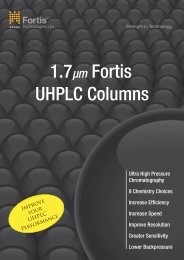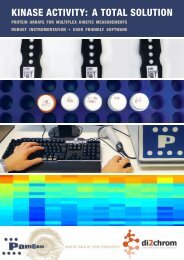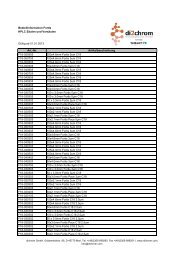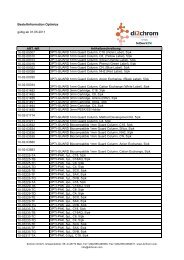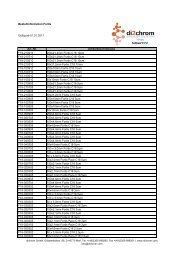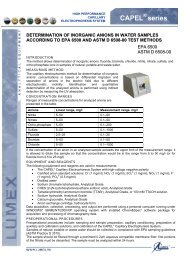Untitled - dichrom
Untitled - dichrom
Untitled - dichrom
You also want an ePaper? Increase the reach of your titles
YUMPU automatically turns print PDFs into web optimized ePapers that Google loves.
5 kD. For size exclusion chromatography, an empirical rule<br />
is that a baseline separation can be achieved for two<br />
compounds if their MWs difference is two fold (2x). Both<br />
Zenix SEC-150 and 300 columns well separated<br />
ribonuclease A (13.7kD) and poly-DL-alanine (1-5 kDa), as<br />
shown in Fig. 6. Thirdly Zenix column shows a good<br />
separation profile of Poly-DL-alanine, indicating Zenix<br />
packing does not have non-specific interactions with Poly-<br />
DL-alanine.<br />
Figure 6. Separation of a mixture of proteins and peptide by using<br />
Zenix SEC-150 and 300 columns.<br />
Zenix SEC-150<br />
1<br />
2<br />
3<br />
4<br />
5<br />
6<br />
Columns: Zenix SEC (3 µm, 7.8x300 mm)<br />
Mobile phase: 0.15 M Sodium Phosphate, pH 7.0<br />
Flow rate: 1.0 mL/min<br />
Detection: UV 214 nm<br />
Injection: 10 µL<br />
Sample: E. coli lysate (2.5 mg/mL)<br />
Separation of Biorad standard protein mixture<br />
Biorad protein mixture of thyroglobulin, -globulin,<br />
ovalbumin, myoglobulin and vitamin B12 have the molecular<br />
weight in the range of 660,000 – 1,355, which has been<br />
used to characterize the performance of SEC columns. The<br />
separation of Biorad protein mixture by Zenix 150 and 300<br />
are shown in Figure 8 with the peak efficiency shown in<br />
Table 4. The plate number of myoglobulin is more than<br />
20,000 with Zenix SEC-300 column, which was not<br />
achieved by any other SEC columns.<br />
Zenix SEC-300<br />
3<br />
4<br />
Figure 8. Separation of Biorad protein mixture by Zenix SEC-150<br />
and 300 columns.<br />
1<br />
2<br />
5<br />
6<br />
Zenix 150<br />
1<br />
0 1 2 3 4 5 6 7 8 9 10 11 12 13 14 15<br />
Min<br />
Columns: Zenix SEC (3 µm, 7.8x300 mm)<br />
Mobile phase: 150 mM Sodium Phosphate, pH 7<br />
Flow rate: 1.0 mL/min<br />
Temperature: Ambient (~23° C)<br />
Detection: UV 214nm<br />
Injection: 10 µL<br />
Sample: 1) Thyroglobulin, 670kD; 2) BSA monomer,<br />
66kD; 3) Ribonuclease A, 13.7kD; 4) poly-DL-alanine, 1-5 kD; 5)<br />
Uracil, 120D.<br />
Separation of E. coli Lysate<br />
Zenix SEC-150 and 300 columns are used to separate the<br />
E. Coli lysate. The elution profiles in Fig. 7 showed both<br />
columns achieved high resolution separation. However,<br />
Zenix SEC-150 is more suitable for separation of E. coli<br />
lysate due to the small molecule weight of the lysate.<br />
Figure 7. Separation of E. coli lysate with various pore size Zenix<br />
columns<br />
Zenix SEC-150<br />
Zenix 300<br />
2<br />
1<br />
0 1 2 3 4 5 6 7 8 9 10 11 12 13 14 15<br />
Min<br />
Columns: Zenix SEC (3 µm, 7.8x300 mm)<br />
Mobile phase: 0.15 M Sodium Phosphate, pH 7.0<br />
Flow rate: 1.0 mL/min<br />
Detection: UV214 nm<br />
Injection: 10 µL<br />
Sample: 1) Thyroglobulin, 670 kD; 2) -Globulin, 158<br />
kD; 3) Ovalbumin, 44 kD; 4) Myoglobulin, 16.9 kD; 5) Vitamin<br />
B12, 1355 D.<br />
Table 4. Efficiency of Zenix SEC-150 and 300 columns<br />
3<br />
2<br />
4<br />
3<br />
5<br />
4 5<br />
Zenix SEC-300<br />
Peak Protein Zenix 150<br />
7.8x300mm<br />
Zenix 300<br />
7.8x300mm<br />
1 Thyroglobulin 12420 1760<br />
2 -Globulin 2860 3650<br />
3 Ovalbumin 6620 11760<br />
4 Myoglobulin 15020 20810<br />
5 Vitamin B12 34370 35460<br />
0.0 1.0 2.0 3.0 4.0 5.0 6.0 7.0 8.0 9.0 10.0 11.0 12.0 13.0 14.0 15.0<br />
Min<br />
www.sepax-tech.com 5 1-877-SEPAX-US



